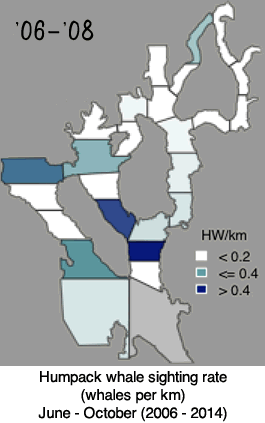Paper reveals the intricate relationship between humpbacks and their habitat
Hermann Meuter and Janie Wray of Cetacea Lab in the Great Bear Rainforest have been studying the region’s abundant populations of marine mammals for more 17 years. They have been a Save Our Seas Foundation partner organisation since 2014.
Originally published on MARKETWIRED:
HARTLEY BAY, BRITISH COLUMBIA
A new study based on an unprecedented decade of local monitoring in Gitga’at First Nation territory, has revealed a previously undetected “wave” pattern (seasonal movement pattern) of humpback whales seasonally using different habitats in large numbers as they navigate the Douglas Channel fjord system.

Animated GIF of “Whale Wave” in Kitimat Fjord. The time series covers whale sightings from June to October between 2008 and 2014 and shows that the whales follow a seasonal pattern, starting in outer waters and moving into the inlet and Douglas Channel.
The “Whale Wave” was discovered by researchers from the Gitga’at First Nation, the North Coast Cetacean Society (NCCS), Scripps Institution of Oceanography at the University of California, and the NOAA-NMFS Southwest Fisheries Science Centre. The study was published in the Marine Ecology Progress Series, a top-tier marine science journal.
“This study shows just how intricate the relationship between humpback whales and their habitat is, and it raises important questions about their conservation,” said Arnold Clifton, Chief Councillor and Hereditary Chief of the Gitga’at First Nation. “In light of the industrial pressures facing our territory, our Nation’s reliance on the sea and the sensitivity and complexity of the area’s ecology, our leadership’s commitment to conservation and long-term local monitoring by our Gitga’at Guardians has never been more important or stronger.”
Though annually persistent and specific in structure, the whale wave had gone unnoticed by typical marine mammal surveys, and was only revealed because of long-term, local monitoring and commitment of thousands of hours of survey time by the Gitga’at First Nation’s Guardian Team and their partners NCCS.
“This wave likely results from humpback familiarizing themselves with this critical habitat over many years and developing specific behaviors, coordinated to the specific oceanography of this fjord system, that enable them to make the greatest use of its resources. This means local displacement by human impacts may have more consequences than previously supposed,” said Eric Keen, a PhD candidate and the paper’s lead author from the Scripps Institution of Oceanography.
“We can’t expect these whales to simply pick up and go somewhere else if industrial activities, such as shipping lanes, disrupt continuity of critical habitats like the Douglas Channel fjord system. Until thorough habitat-use studies are completed, irrevocable management decisions should be treated with caution.”
In addition to revealing a pattern of whale behavior that has never been seen before, the study also suggests that the whale wave is being driven by needs other than food, potentially including physical and social habitat needs such as bathymetry (depth) and acoustic properties of the fjords for communication and singing, and companionship for the purpose of traveling within a group or mating.
“Our findings suggest humpback foraging needs within this fjord system are balanced against needs other than food and that the balance shifts through the year,” said Janie Wray, a whale researcher with the North Coast Cetacean Society. “This behaviour may accommodate higher densities of humpbacks in the dwindling number of relatively undisturbed coastal habitats of the northeast Pacific, than would otherwise be possible. More research needs to be done to fully understand what this whale wave means and what its implications for whale conservation might be.”
To find out more about the Great Bear Rainforest and the threats facing these whales and their habitat watch:
